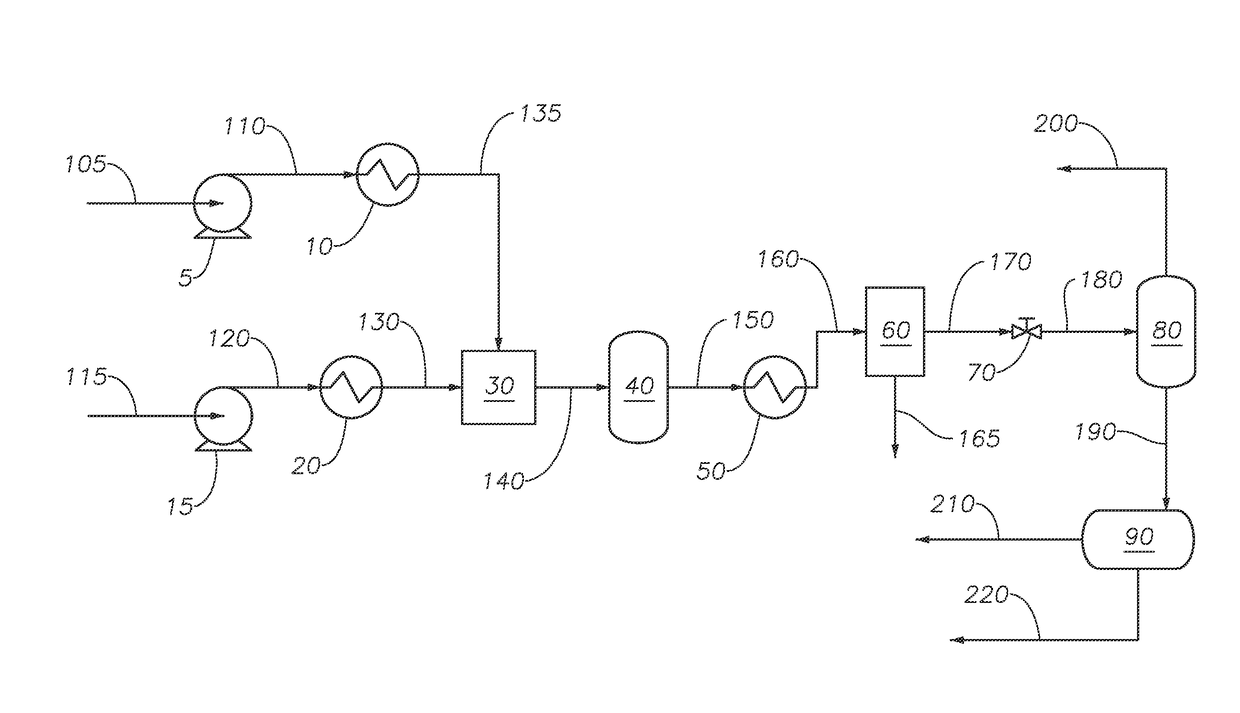Method to remove metals from petroleum
a metal and petroleum technology, applied in the direction of hydrocarbon oil refining, thermal non-catalytic cracking, water treatment, etc., can solve the problems of severe corrosion of metal parts of gas turbines, corrosion problems in hydrocarbon combustion processes, and problems in refining and other downstream processes
- Summary
- Abstract
- Description
- Claims
- Application Information
AI Technical Summary
Benefits of technology
Problems solved by technology
Method used
Image
Examples
example
Example 1
[0054]A process for demetallizing a petroleum feedstock in the presence of supercritical water was carried out in a pilot scale plant according to the configuration as shown in FIG. 2. Petroleum feedstock 105 was a whole range Arabian Light crude oil at a volumetric flow rate of 0.2 Liter / hour (L / hour). The temperature of petroleum feedstock 105 was 21° C. and the pressure was increased to a pressure of 25 MPa in petroleum pump 5 to produce pressurized feedstock 110. The temperature of pressurized feedstock 110 was raised to 50° C. in petroleum pre-heater 10 to produce heated feedstock 135, still at a pressure of 25 MPa. Water stream 115 was at a volumetric flow rate of 0.6 L / hour at a temperature of 17° C. and increased to a pressure of 25 MPa in water pump 15 to produce pressurized water 120. Pressurized water 120 was heated in water pre-heater 20 to a temperature of 480° C. to produce heated water stream 130. Heated water stream 130 and heated feedstock 135 were fed to m...
example 2
[0056]Example 2 was a pilot scale simulation conducted according to the set-up described with reference to FIG. 3 and example 1. In example 2, activated carbon was added to liquid product 192 at a weight ratio of activated carbon to liquid product of 1:200 (0.5 wt % of carbon black was added to liquid product 192). The mixture was subjected to ultrasonic irradiation in ultrasonic generator 96 for 15 minutes. Next, the mixture was stirred at 50° C. After being stirred, the mixture was centrifuged in oil-water separator 90 to produce water product 222 and petroleum 212. Tests showed that the activated carbon was in water product 222. Liquid yield was 99 wt %. Petroleum 212 had a vanadium content of 0.4 wt ppm. The results of example 2 show that the rejecter (in this example, a centrifuge was used to concentrate the sludge in the bottom of a centrifuge tube). and an adsorbent can remove a metals impurity from a petroleum feedstock.
[0057]Although the present invention has been described...
PUM
| Property | Measurement | Unit |
|---|---|---|
| temperature | aaaaa | aaaaa |
| wt % | aaaaa | aaaaa |
| critical temperature | aaaaa | aaaaa |
Abstract
Description
Claims
Application Information
 Login to View More
Login to View More - R&D
- Intellectual Property
- Life Sciences
- Materials
- Tech Scout
- Unparalleled Data Quality
- Higher Quality Content
- 60% Fewer Hallucinations
Browse by: Latest US Patents, China's latest patents, Technical Efficacy Thesaurus, Application Domain, Technology Topic, Popular Technical Reports.
© 2025 PatSnap. All rights reserved.Legal|Privacy policy|Modern Slavery Act Transparency Statement|Sitemap|About US| Contact US: help@patsnap.com



